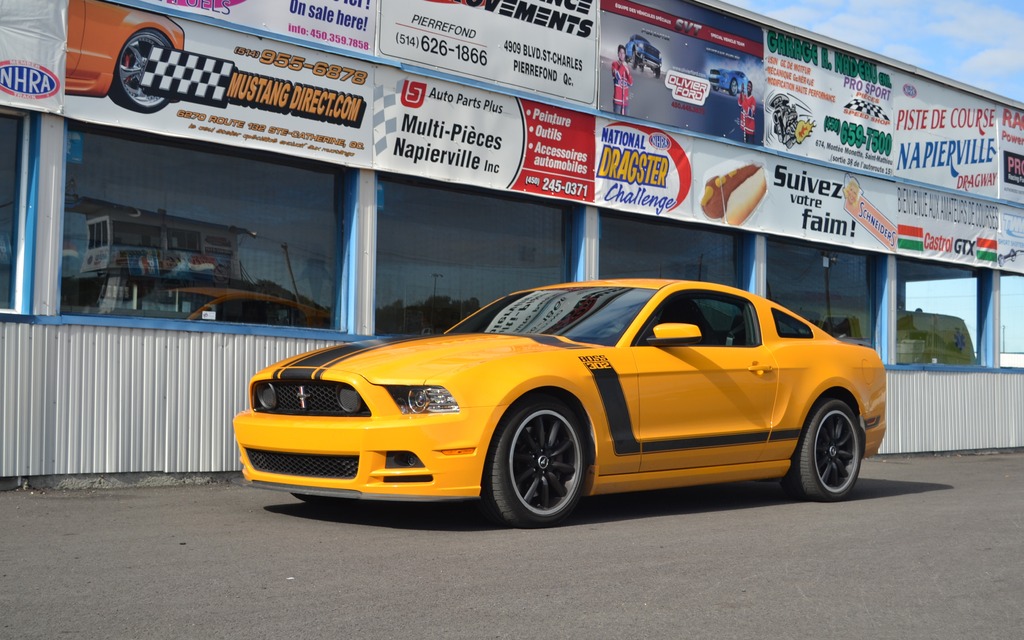2013 Ford Mustang Boss 302: All about balance


Ford has always managed to stoke the public’s passion for its sport coupe, mainly by introducing a wide array of versions and special editions over the years. Each time, this rekindles the flame in the heart of enthusiasts. Add to that the fact that the competition has never been able to imitate this exceptional achievement, which has undoubtedly helped Mustang enjoy success for decades. There’s a Mustang for all tastes: affordable, convertible, high-performance and downright demonic. Regardless of the version, the one common denominator is its hard-to-match price/performance ratio. And lest we forget, it’s a Mustang, and the name alone is enough to stir up passions.
We recently had the opportunity to try the full bevy of Mustangs on the Calabogie track in the Ottawa area. Although the Mustang Shelby GT500 and its 650 horses commands respect, our favourite was the Boss 302 with its near perfect balance. This rocket has been conditioned from a very young age to perform on a track, but as it turns out, it proved just as much fun during our test drive, which was peppered with everyday activities. From the circuit to the daily grind, the Boss 302 was amazing, especially for our children. Suddenly, car trips weren’t such a chore. Sure, the Boss 302 is no family wagon, but it turns a lot of heads when you pull up at your destination.
Less torque, but more horses
The Mustang Boss 302 is inspired by the GT version, but it stands out primarily because of its flashier colours (School Bus Yellow, Gotta Have It Green, Metallic Tintcoat, Grabber Blue…), while the graphics kit, including the Boss 302 logo affixed in the upper part of the fenders, makes it quickly recognizable. We should also mention its exclusive rims and honeycomb-pattern front grille, from which the fog lights have been removed. A small spoiler and hood with an integrated heat extractor completes the look.
The engine is the heart of the Boss 302. While the GT has a 5.0-litre V8 featuring 420 horses and 390 lbs-ft or torque, the Boss 302 inherits the same V8, but with 444 horses with a 10 lbs-ft less of torque. Fear not, they make up for this loss of torque in other ways. This engine can withstand high gears longer, which is a prerequisite when you’re having fun on a track the whole day.
What better than a six-speed manual transmission to complete the package and give us the impression of driving a true race car? It’s totally unlike those sterilized modern sports cars with twin-clutch gearboxes. Don’t get me wrong, those cars perform well, but they put a damper on the thrill of the ride. There’s something to be said for needing a little dexterity to control a car and push it to its limits.
Inside, the changes are less significant but still notable. The Boss has anthracite black seats with the Boss 302 logo embroidered on the headrest, while its suede-covered steering wheel is a nice, comfortable touch. But don’t expect a family car with a lot of room for passengers in the back: you’re barking up the wrong tree with this car!
On the road and on the track
The Mustang Boss 302 offers few options, but one that you’ll want to consider is the Track key. It comes with a second key to start the car, so you have one black and one red key bearing the Boss 302 logo. No, it’s not an extra key. The red one fully liberates the car’s capabilities, adjusting more than 400 settings to optimize this beast’s performances, from the injection to the engine deceleration, which is a feature that helps save the brakes. Insert the black key and car is optimized for the road in no time at all, an interesting idea that helps you quickly and easily transforms the car’s performance according to your needs, or at least, your schedule.
Once it’s started, the Boss 302’s engine gets the driver’s juices flowing as does the thrilling sound that the V8 emits via the Boss 302’s exclusive quadruple exhaust. Although it has 200 horses less than the Shelby GT 500, the Boss 302 was our favourite of all the Mustangs tested on the circuit thanks to its predictability, the nearly 50/50 weight distribution and reduced weight transfers. This true monster has come a long way from past models that weren’t agile in turns or when braking. At the wheel, it feels very light, which is surprising considering the car’s weight. The secret behind its handling is that, compared to the GT, it’s 11 mm lower in front, 1 mm lower in back, has firmer springs and thicker roll bars.
On board, we liked the excellent visibility and the Recaro seat, which kept us snugly in place when cornering. For everyday driving, these seats weren’t too punishing; you might even say they remained comfortable. And just like the GT, the Boss 302 is as high performance on the track as it is fun to drive for your day-to-day needs.
Be that as it may, the Boss 302 is currently the most accomplished of all Mustangs and it’s a safe bet that if you keep one in the back of a barn, it could be worth a small fortune in a few dozen years.








